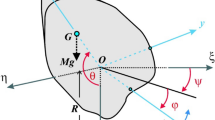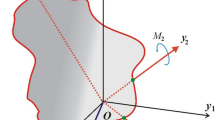Abstract
In this article, we study the three-dimensional rotational motion of a symmetric rigid body (gyro) about a fixed point under the influence of a gyrostatic moment vector about the principal axes of inertia according to Kovalevskaya’s conditions. The six nonlinear differential equations of motion beside their first integrals are reduced to two differential equations from second order composed an autonomous system with one first integral. It is taken into consideration that the gyro spins with high angular velocity about one of the orthogonal principal axes. The small parameter method is used to obtain the analytical solutions of the governing system. The attained solutions are represented graphically through several plots concerning with the different values of the gyrostatic moment vector to evaluate the performance of these values on the gyro’s motion. Euler’s angles are estimated to describe the motion at any instant. The fourth-order Runge–Kutta algorithms through Matlab packages are used to obtain the numerical solutions for the mentioned problem and to represent these solutions graphically. A comparison between the analytical and the numerical solutions shows high consistency between them which indicates the powerful of the presented analytical technique. The phase plane plots are presented in order to give a full description about the regular motion of the gyro. The considered subject has a great interest in many applications such as submarines, satellites and aircrafts.















Similar content being viewed by others
References
Akulenko LD, Zinkevich Ya S, Leshchenko DD (2011) Optimal rotation deceleration of a dynamically asymmetric body in a resistant medium. J Comput Syst Sci Int 50:14–19
Akulenko LD, Leshchenko DD, Rachinskaya AL (2014) Quasi-optimal deceleration of rotations of an asymmetric body in resistive medium. J Comput Syst Sci Int 53(3):338–344
Amer TS (2004) Motion of a rigid body analogous to the case of Euler and Poinsot. Analysis 24:305–315
Amer TS (2008) On the motion of a gyrostat similar to Lagrange’s gyroscope under the influence of a gyrostatic moment vector. Nonlinear Dyn 54:249–262
Amer TS, Ismail AI, Amer WS (2012) Application of the Krylov–Bogoliubov–Mitropolski technique for a rotating heavy solid under the Influence of a gyrostatic moment. J Aerosp Eng 25(3):421–430
Arkhangel’skii IA (1963a) On the motion about a fixed point of a fast spinning heavy solid. J Appl Math Mech 27(5):1314–1333
Arkhangel’skii IA (1963b) On a motion of an equilibrated gyroscope in the Newtonian force field. J Appl Math Mech 27(6):1684–1688
Arkhangel’skii IA (1975) Construction of periodic solutions for the Euler–Poisson equations by means of power series expansion containing a small parameter, Colloquia Mathematica Societatis Janos Bolyai, Keszthely (Hungary)
Ashayer P (2007) Application of rigid body impact mechanics and discrete element modeling to rockfall simulation, Ph.D. Thesis, Toronto University, Canada
Bogoliubov NN, Mitropolski YA (1961) Asymptotic methods in the theory of non-linear oscillations. Gordon and Breach, New York
Borisov AV, Mamaev IS (2005) Rigid body dynamics: Hamiltonian methods, integrability, chaos. RCD, Moscow–Izhevsk (in Russian)
Chaplygin SA (1903) A new partial solution of the problem of motion of a rigid body in a liquid, Trudy Otdel. Fiz Nauk Obsh Liub Est 11:7–10
El-Barki FA, Ismail AI (1995) Limiting case for the motion of a rigid body about a fixed point in the Newtonian force field. ZAMM 75(11):821–829
Elfimov VS (1978) Existence of periodic solutions of equations of motion of a solid body similar to the Lagrange gyroscope. J Appl Math Mech 42(2):251–258
Elmandouh AA (2015) New integrable problems in rigid body dynamics with quartic integrals. Acta Mech 226:2461–2472
Gluhovsky A, Christopher T (1999) The structure of energy conserving low-order models. Phys Fluids 11:334–337
Hughes PC (1986) Spacecraft attitude dynamics. Wiley, New York
Ismail AI (1996) On the application of Krylov–Bogoliubov–Mitropolski technique for treating the motion about a fixed point of a fast spinning heavy solid. ZFW 20:205–208
Ismail AI (2000) Periodic solutions of equations of motion of a heavy solid applying Krylov–Bogoliubov–Mitropolski method. J Comput Appl Math 114:345–359
Ismail AI, Sperling L, Amer TS (2000) On the existence of periodic solutions of a gyrostat similar to Lagrange’s gyroscope. Tech Mech 20(4):295–304
Maznev AV (2013) A class of three invariant relations for the equations of motion of a gyrostat with a variable gyrostatic moment. J Appl Math Mech 77:190–194
Nayfeh AH (2000) Perturbation methods. Wiley, New york
Tong W (2016) Coupled rigid body dynamics with application to diving, Ph.D. Thesis, Sydney University, USA
Walter J, Gonzalez O, Maddocks JH (2010) On the stochastic modelling of rigid body systems with application to polymer dynamics. Multiscale Model Simul 8(3):1018–1053
Yehia HM (1986a) On the integrability of certain problems in particle and rigid body in an axisymmetric field. J Mecan Theor Appl 5:55–71
Yehia HM (1986b) On the motion of a rigid body acted upon by potential and gyroscopic forces. I. The equations of motion and their transformations. J Mech Theor Appl 5(5):747–754
Yehia HM (1997) New generalizations of the integrable problems in rigid body dynamics. J Phys A Math Gen 30:7269–7275
Yehia HM (1999) New generalizations of all the known integrable problems in rigid body dynamics. J Phys A Math Gen 30:7565–7580
Yehia HM (2003) Kovalevskaya’s integrable case: generalization and related new results. Regul Chaot Dyn 8(3):337–348
Yehia HM, Elmandouh AA (2011) New conditional integrable cases of motion of a rigid body with Kovalevskaya’s configuration. J Phys A Math Gen 44:1–8
Yehia HM, Elmandouh AA (2013) A new integrable problem with quartic integral in the dynamics of a rigid body. J Phys A Math Gen 46:1–8
Author information
Authors and Affiliations
Corresponding author
Appendix 1
Appendix 1
From (16) and (24), we can write
Since
Substituting (ii) into (16), gives
Using (ii), we obtain
That is,
Then, one obtains the first equation of systems (28). Similarly the other three equations can be obtained easily.
Rights and permissions
About this article
Cite this article
Amer, T.S., Amer, W.S. The Rotational Motion of a Symmetric Rigid Body Similar to Kovalevskaya’s Case. Iran J Sci Technol Trans Sci 42, 1427–1438 (2018). https://doi.org/10.1007/s40995-017-0221-1
Received:
Accepted:
Published:
Issue Date:
DOI: https://doi.org/10.1007/s40995-017-0221-1




